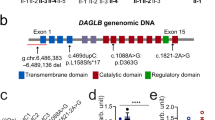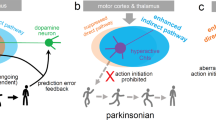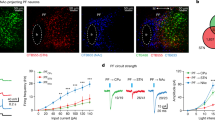Abstract
The striatum is a major forebrain nucleus that integrates cortical and thalamic afferents and forms the input nucleus of the basal ganglia1,2. Striatal projection neurons target the substantia nigra pars reticulata (direct pathway) or the lateral globus pallidus (indirect pathway). Imbalances between neural activity in these two pathways have been proposed to underlie the profound motor deficits observed in Parkinson's disease and Huntington's disease3,4. However, little is known about differences in cellular and synaptic properties in these circuits. Indeed, current hypotheses suggest that these cells express similar forms of synaptic plasticity5,6. Here we show that excitatory synapses onto indirect-pathway medium spiny neurons (MSNs) exhibit higher release probability and larger N-methyl-d-aspartate receptor currents than direct-pathway synapses. Moreover, indirect-pathway MSNs selectively express endocannabinoid-mediated long-term depression (eCB-LTD), which requires dopamine D2 receptor activation. In models of Parkinson's disease, indirect-pathway eCB-LTD is absent but is rescued by a D2 receptor agonist or inhibitors of endocannabinoid degradation. Administration of these drugs together in vivo reduces parkinsonian motor deficits, suggesting that endocannabinoid-mediated depression of indirect-pathway synapses has a critical role in the control of movement. These findings have implications for understanding the normal functions of the basal ganglia, and also suggest approaches for the development of therapeutic drugs for the treatment of striatal-based brain disorders.
This is a preview of subscription content, access via your institution
Access options
Subscribe to this journal
Receive 51 print issues and online access
$199.00 per year
only $3.90 per issue
Buy this article
- Purchase on Springer Link
- Instant access to full article PDF
Prices may be subject to local taxes which are calculated during checkout




Similar content being viewed by others
References
Wilson, C. J. in The Synaptic Organization of the Brain (ed. Shepherd, G. M.) 329–375 (Oxford University Press, New York, 1998)
Bolam, J. P., Hanley, J. J., Booth, P. A. & Bevan, M. D. Synaptic organisation of the basal ganglia. J. Anat. 196, 527–542 (2000)
Albin, R. L., Young, A. B. & Penney, J. B. The functional anatomy of basal ganglia disorders. Trends Neurosci. 12, 366–375 (1989)
Graybiel, A. M. The basal ganglia. Curr. Biol. 10, R509–R511 (2000)
Gerdeman, G. L., Partridge, J. G., Lupica, C. R. & Lovinger, D. M. It could be habit forming: drugs of abuse and striatal synaptic plasticity. Trends Neurosci. 26, 184–192 (2003)
Wang, Z. et al. Dopaminergic control of corticostriatal long-term synaptic depression in medium spiny neurons is mediated by cholinergic interneurons. Neuron 50, 443–452 (2006)
Gerfen, C. R. et al. D1 and D2 dopamine receptor-regulated gene expression of striatonigral and striatopallidal neurons. Science 250, 1429–1432 (1990)
Obeso, J. A. et al. Pathophysiologic basis of surgery for Parkinson’s disease. Neurology 55, S7–S12 (2000)
Mallet, N., Ballion, B., Le Moine, C. & Gonon, F. Cortical inputs and GABA interneurons imbalance projection neurons in the striatum of parkinsonian rats. J. Neurosci. 26, 3875–3884 (2006)
Gong, S. et al. A gene expression atlas of the central nervous system based on bacterial artificial chromosomes. Nature 425, 917–925 (2003)
Lobo, M., Karsten, S., Gray, M., Geschwind, D. & Yang, X. FACS-array profiling of striatal projection neuron subtypes in juvenile and adult mouse brains. Nature Neurosci. 9, 443–452 (2006)
Zucker, R. S. & Regehr, W. G. Short-term synaptic plasticity. Annu. Rev. Physiol. 64, 355–405 (2002)
Dingledine, R., Borges, K., Bowie, D. & Traynelis, S. F. The glutamate receptor ion channels. Pharmacol. Rev. 51, 7–61 (1999)
Calabresi, P., Maj, R., Pisani, A., Mercuri, N. B. & Bernardi, G. Long-term synaptic depression in the striatum: physiological and pharmacological characterization. J. Neurosci. 12, 4224–4233 (1992)
Gerdeman, G. L., Ronesi, J. & Lovinger, D. M. Postsynaptic endocannabinoid release is critical to long-term depression in the striatum. Nature Neurosci. 5, 446–451 (2002)
Kreitzer, A. C. & Malenka, R. C. Dopamine modulation of state-dependent endocannabinoid release and long-term depression in the striatum. J. Neurosci. 25, 10537–10545 (2005)
Tang, K., Low, M. J., Grandy, D. K. & Lovinger, D. M. Dopamine-dependent synaptic plasticity in striatum during in vivo development. Proc. Natl Acad. Sci. USA 98, 1255–1260 (2001)
Calabresi, P. et al. Abnormal synaptic plasticity in the striatum of mice lacking dopamine D2 receptors. J. Neurosci. 17, 4536–4544 (1997)
Giuffrida, A. et al. Dopamine activation of endogenous cannabinoid signaling in dorsal striatum. Nature Neurosci. 2, 358–363 (1999)
Betarbet, R., Sherer, T. B. & Greenamyre, J. T. Animal models of Parkinson’s disease. BioEssays 24, 308–318 (2002)
Schwarting, R. K. & Huston, J. P. Unilateral 6-hydroxydopamine lesions of meso-striatal dopamine neurons and their physiological sequelae. Prog. Neurobiol. 49, 215–266 (1996)
Kathuria, S. et al. Modulation of anxiety through blockade of anandamide hydrolysis. Nature Med. 9, 76–81 (2003)
Di Marzo, V., Hill, M. P., Bisogno, T., Crossman, A. R. & Brotchie, J. M. Enhanced levels of endogenous cannabinoids in the globus pallidus are associated with a reduction in movement in an animal model of Parkinson’s disease. FASEB J. 14, 1432–1438 (2000)
Gubellini, P. et al. Experimental parkinsonism alters endocannabinoid degradation: implications for striatal glutamatergic transmission. J. Neurosci. 22, 6900–6907 (2002)
Jenner, P. Dopamine agonists, receptor selectivity and dyskinesia induction in Parkinson’s disease. Curr. Opin. Neurol. 16, (Suppl. 1)S3–S7 (2003)
Makara, J. K. et al. Selective inhibition of 2-AG hydrolysis enhances endocannabinoid signaling in hippocampus. Nature Neurosci. 8, 1139–1141 (2005)
Saario, S. M. et al. URB754 has no effect on the hydrolysis or signaling capacity of 2-AG in the rat brain. Chem. Biol. 13, 811–814 (2006)
Baik, J. H. et al. Parkinsonian-like locomotor impairment in mice lacking dopamine D2 receptors. Nature 377, 424–428 (1995)
Zimmer, A., Zimmer, A. M., Hohmann, A. G., Herkenham, M. & Bonner, T. I. Increased mortality, hypoactivity, and hypoalgesia in cannabinoid CB1 receptor knockout mice. Proc. Natl Acad. Sci. USA 96, 5780–5785 (1999)
Compton, D. R., Aceto, M. D., Lowe, J. & Martin, B. R. In vivo characterization of a specific cannabinoid receptor antagonist (SR141716A): inhibition of delta 9-tetrahydrocannabinol-induced responses and apparent agonist activity. J. Pharmacol. Exp. Ther. 277, 586–594 (1996)
Acknowledgements
We thank W. Regehr, B. Sabatini, D. Lovinger, D. Piomelli, J. Surmeier and members of the Malenka laboratory for helpful discussions, X. W. Yang for providing BAC-transgenic mice generated by the GENSAT project, M. Xu-Friedman for providing custom Igor acquisition software, and S. Y. Lee and X. Cai for technical help. This work was supported by a Ruth L. Kirchenstein Fellowship (A.C.K.), a grant from the National Institutes of Health (R.C.M.), and a National Parkinson Foundation Individual Research Grant (R.C.M. and A.C.K.).
Author information
Authors and Affiliations
Corresponding author
Ethics declarations
Competing interests
Reprints and permissions information is available at www.nature.com/reprints. The authors declare no competing financial interests.
Supplementary information
Supplementary Information
This file contains Supplementary Methods, Supplementary Figures 1-5 with Legends and additional references. (PDF 625 kb)
Rights and permissions
About this article
Cite this article
Kreitzer, A., Malenka, R. Endocannabinoid-mediated rescue of striatal LTD and motor deficits in Parkinson's disease models. Nature 445, 643–647 (2007). https://doi.org/10.1038/nature05506
Received:
Accepted:
Issue Date:
DOI: https://doi.org/10.1038/nature05506
This article is cited by
-
Postsynaptic synucleins mediate endocannabinoid signaling
Nature Neuroscience (2023)
-
Striatonigral direct pathway 2-arachidonoylglycerol contributes to ethanol effects on synaptic transmission and behavior
Neuropsychopharmacology (2023)
-
Ongoing movement controls sensory integration in the dorsolateral striatum
Nature Communications (2023)
-
CNTN1 in the Nucleus Accumbens is Involved in Methamphetamine-Induced Conditioned Place Preference in Mice
Neurotoxicity Research (2023)
-
A story of the potential effect of non-steroidal anti-inflammatory drugs (NSAIDs) in Parkinson’s disease: beneficial or detrimental effects
Inflammopharmacology (2023)
Comments
By submitting a comment you agree to abide by our Terms and Community Guidelines. If you find something abusive or that does not comply with our terms or guidelines please flag it as inappropriate.



